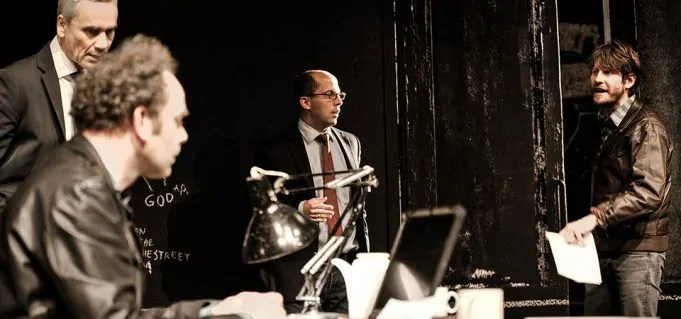Is truth more important than democracy?
In Ibsen’s An Enemy of the People, a doctor discovers that a spa town’s water source is polluted. He makes enemies as he tries to spread the news, which is sure to hurt the town economy. The attacks make him realize that the problem extends beyond the water source – he calls a town assembly and denounces the rotten state of society, where the majority can have power without being right. That’s where he crosses the line from defender of truth to dangerous fanatic: he advocates the extermination of the dumb majority, or at least those who lead them astray.
At least, it’s clear to me that Dr. Stockmann goes too far. In the Schaubühne Berlin’s touring production, Berkeley audiences got a say – and they didn’t seem to agree. After the doctor’s speech (and before the resulting chaos), the house lights came up and the actors turned to us. The comments all supported Dr. Stockmann’s anti-capitalist, undemocratic ideas. Aslaksen (the upstanding president of the town homeowners’ association) tried to rebut audience points and highlight the violence of Dr. Stockmann’s ideas, but he didn’t make much headway. The result was a frustrating stream of self-satisfied righteousness, rather than the debate the production presumably hoped to incite.
When the action was happening on the stage, director Thomas Ostermeier’s choices were bold and striking. The entire set was covered in chalkboard paint, with perspective lines, signs, and labels in white chalk. To move between spaces and days, characters simply erased or added to the walls. For Dr. Stockmann’s speech, they repainted the whole set onstage, as the audience watched. At the end of the doctor’s tirade, the other characters pelted him with water balloons filled with yellow paint, which elicited a visceral response and created a memorable, symbolic image.
Although true to Ibsen’s plot, Florian Borchmeyer’s version of the script and Ostermeier’s staging introduced a quirky sense of modernity, with frantic juggling of phones and a personified radio set. A beatboxing showdown was the play’s comedic highlight, but an ape impersonation, gratuitous chair-reshuffling, and weed jokes all got plenty of laughs as well. Hovstad, Billing, and the Stockmanns played in a band together, providing energetic music between and during scenes.

(credit: Arno Declair)
Unfortunately, the play was bogged down by languid pacing. Running for more than two and a half hours (without an intermission!) creates an obligation to be consistently gripping. The climactic moments were indeed engrossing, but they needed less filler between them. Songs, Dr. Stockmann’s meandering speech, and the audience participation section could all have been shortened with no great loss to the production’s message.
At the end of the play, Dr. Stockmann’s father-in-law gives him a double-edged gift: a large financial stake in the town spa. Ibsen’s character makes it clear that he intends to go on fighting; this Schaubühne production left the doctor’s intentions more ambiguous. A scary thought: that someone with Stockmann’s disregard for the morality of his means could also be corrupted to unjust ends.



